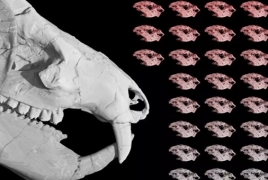
A “rarest of the rare” fossil of an enormous fanged rat-like animal surrounded by a litter of 38 hatched and unhatched offspring has been unearthed in Arizona, offering new insight into the transition between reptiles and mammals during the Jurassic period, The Independent reports.
Mammals are today distinguished by their means of reproduction in which they produce relatively few, live young. In comparison, reptiles lay large clutches of eggs.
But this find, reported in the journal Nature, shows the species, which is very close to modern mammal species, still had a primitive form of reproduction, and laid eggs in the same numbers as reptiles.
The creature, named Kayentatherium wellesi, and which was a forerunner to modern mammals and belonged to a group known as the tritylodonts, was about the size of a small dog, and had large fangs on both its upper and lower jaw.
Despite its appearance, it was herbivorous, and would have lived alongside dinosaurs about 185 million years ago.
The remarkable discovery of the animal’s offspring comes a full 18 years after the initial mother’s remains were found, when palaeontologists re-examined the sediment sample and carried out CT scans to reveal the huge litter.
“Looking at the CT scans I was able to discover baby after baby after baby,” said study leader Eva Hoffman, who led the research as a graduate student in geosciences at the University of Texas at Austin.
“These babies are from a really important point in the evolutionary tree,” she added. “They had a lot of features similar to modern mammals, features that are relevant in understanding mammalian evolution.”
Zhe-Xi Luo, a palaeontologist and professor at The University of Chicago, described the discovery as “stunning” and said they would provide scientists valuable insight into mammal evolution.
“These great fossils really gave us a rare glimpse of how early mammals evolved from their ancestors,” he said.
The highly detailed scans allowed Ms Hoffman to examine the shape of the offsprings’ skulls, which appear as “scaled down replicas” a tenth of the size of the adult and with all features in proportion - a trait typically seen in reptile offspring. In modern mammals, young are born with shortened faces and bulbous heads to account for big brains.

